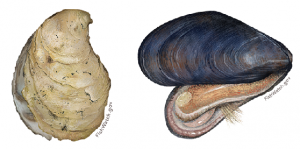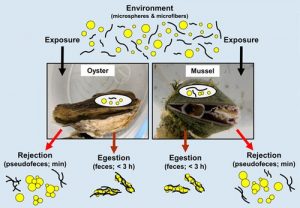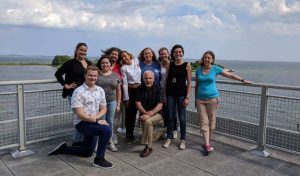Stories about the impact of plastic pollution on marine organisms have been flooding the news with upsetting images of sea turtles with plastic straws stuck in their nostrils, and whales dying with tons of plastic in their stomachs. Besides large animals, plastic is potentially harming the creatures that wind up on our dinner plate, like bivalve shellfish. Bivalves filter ocean water to eat plankton, which suggests they are ingesting small plastic particles, called microplastics, every time they feed.
Researchers in UConn’s Department of Marine Sciences recently conducted a study exploring how common, commercial bivalves interact with microplastics when filter feeding. Ph.D. students Kayla Mladinich and Tyler Griffin, working with Professor J. Evan Ward, collected eastern oysters and blue mussels from Long Island Sound for laboratory experiments, in which they were exposed to plastic spheres and/or plastic threads of different sizes.

For spheres, their findings show that both mussels and oysters always reject the largest-sized plastic spheres, but ingest and expel smaller ones. For threads, however, there was not a clear pattern between rejection or ingestion, and length.
Mladinich explains, “Bivalves are selective feeders. While they can capture particles of various sizes and shapes on their gills, they will not eat everything they are exposed to. They can ingest or reject certain particles based on the size, shape, and surface properties.”
Dr. Ward and his lab group have shown that bivalves are not passively ingesting all types of plastics, rather the size and shape of the plastic matter a lot. This finding has implications for using bivalves as bioindicators for plastic pollution in the ocean.
Bioindicators are species used to represent the concentrations of pollutants and contaminants in an environment. In the ocean, bivalves are already utilized to monitor and determine levels of persistent organic pollutants (POPs), which can cause a variety of diseases in humans.
According to the World Health Organization, the most commonly encountered POPs are pesticides, industrial chemicals, and unintentional by-products of many industrial processes, such as DDT, PCB and PCDD, respectively. Recently, some scientists suggest also using bivalves as bioindicators for plastics pollution in the ocean.

According to the Ward lab, the criteria for a good microplastics bioindicator species include (1) being ubiquitous and relatively easy to collect; (2) interacting significantly with the surrounding environment through particle-feeding processes; and (3) ingesting, without bias, the majority of plastic particles in the environment.
Therefore, says Mladinich, “We should reconsider using bivalves as bioindicators for microplastics pollution, because as this study shows they capture, ingest, and reject plastic particles differentially. Bivalves are not consuming particles passively; they have selection mechanisms and bias.”
“If you went out and opened up a mussel or oyster and counted all the types and sizes of microplastic particles, you would not be getting an accurate representation of the microplastic load in that area,” added Griffin. “We should investigate other filter feeders that better satisfy our criteria.”
Unfortunately, mussels and oysters do not follow these criteria because they selectively consume some microplastics over others. Additional studies suggest that most plastics do not accumulate in shellfish tissues because they are readily eliminated on short timescales. “Our study supports the idea that many plastic particles encountered by bivalves are either rejected prior to ingestion or rapidly egested in feces, so the instantaneous microplastic body burden of the animals is low,” explains Dr. Ward. Nonetheless, long-term effects of a low microplastic body burden in bivalves are not yet known.
More experiments are being conducted by Dr. Ward and his students that explore the impacts of microplastics on the gut microbiome of mussels, the selection of microscopic fibers depending on size and polymer type, and other topics.
